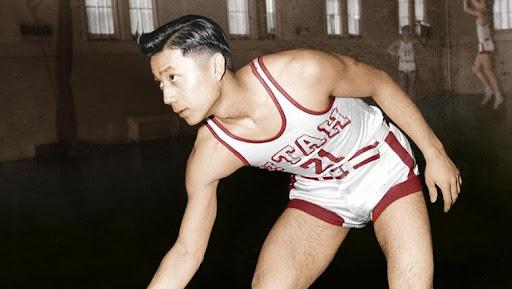ANHPI trailblazers in sports

👊 Blazing a trail
In the 1940s, several ANHPI athletes across North America became “firsts'' in their sports, blazing a trail for generations of athletes to come. The first of the firsts was former NY Knick Wataru Misaka, who became the NBA’s first Asian American and first non-white player in 1947.
- A year later, in 1948, Larry Kwong joined the NY Rangers as the NHL’s first Asian Canadian player and diver Victoria Manalo Draves became the first-ever Asian American Olympic champion in 1948.
But their journeys sadly came with the added obstacle of racism. Draves initially used her English mother’s maiden name while competing, while Kwong only played one minute in the NHL (though was a star in other leagues). As one of his friends said, “It was hard to catch a break when you looked like Larry did.”
Fast forward 50 years and ANHPI athletes continue to leave their mark on the historically white sports landscape. One high-profile example? Figure skater Kristi Yamaguchi.
- Yamaguchi became an American sports icon when she won Olympic gold in 1992 and also paved the way for Asian Americans in a sport often described as “the domain of white Americans and Europeans.” Inclusivity wins gold medals.
💪 The kids are alright
This generation of ANHPI athletes is successfully carrying the torch. In recent years, a handful have emerged as champions in their respective sports, from college to the Olympics.
- Look no further than the aforementioned Suni Lee, who followed up her Tokyo Games gold-medal victory with an NCAA individual national championship on the balance beam for Auburn the following year.
- Players also took center stage at the Beijing 2022 Winter Olympics, where snowboarder Chloe Kim and ice skater Nathan “Quad King” Chen took home gold medals of their own.
Evidently, the roster of talent is only getting deeper. 2021 U.S. Open champion Emma Raducanu and finalist Leylah Fernandez are considered two of tennis’ rising stars, while golf diehards are banking on Rose Zhang to dominate the LPGA Tour after winning last month’s Augusta National Women’s Amateur. The future is bright.
ANHPI athletes from around the world are earning the spotlight, too. LA Angels pitcher Shohei Ohtani is leaving his mark in MLB and at the World Baseball Classic, where Japan recently took home top honors, while Australian soccer star Sam Kerr is expected to be the face of the FIFA Women’s World Cup when the tournament heads Down Under in July.
- New Zealand’s Lydia Ko is one of golf’s top talents and currently ranks second on the LPGA Tour, while Chinese freestyle skier and two-time Olympic gold medalist Eileen Gu inspired girls around the world to pick up the sport after dominating in Beijing last year.
Women’s sports also reached new heights in Asia this year with the inaugural Women’s Premier League (WPL) season. The Indian cricket league began with a bang — Paramount’s Viacom18 paid $116M for broadcast rights, team owners forked over a cumulative $573M to join the league, and 50K fans attended the first-ever WPL final in March.
💼 Taking charge
Away from the field of play, Asians, Native Hawaiians, and Pacific Islanders are changing the game. Hawaiian congresswoman Patsy Mink was already a trailblazer as the first woman of color elected to the U.S. Congress, but she ushered in an entirely new era in American sports as one of the chief architects behind Title IX.
Off-the-field ANHPI power players are still blazing trails five decades later. The Miami Heat’s Erik Spoelstra became the NBA’s first Asian head coach in 2008, while Rich Cho was tapped as the league’s first Asian general manager (GM) in 2010, leading the aptly named Portland Trail Blazers.
- In 2020, the Miami Marlins’ Kim Ng became MLB’s first female GM. Two years later, LA Kings trainer Aisha Visram was the first South Asian (and second-ever woman) to serve behind an NHL bench, and Michele Kang became the first woman of color to own an NWSL team.
- Asians are also earning spots at the highest levels of sports media. Mina Kimes spits facts about the NFL on the regular for ESPN, while LA Dodgers’ play-by-play broadcaster Stephen Nelson is the only Asian announcer in MLB.
Plus, ANHPI athletes are making an impact on sports in more ways than one. Snowboarder Kim is one of four iconic female athletes who founded Togethxr, a media company dedicated to women’s sports. Tennis icon Naomi Osaka, meanwhile, is building quite the business résumé when she isn’t hitting the court.
- Osaka’s portfolio includes sunscreen line Kinlò, with products designed specifically for melanated skin, and production company Hana Kuma. One of her first projects? A documentary about Congresswoman Mink. Game recognizing game.
❤️ Stop ANHPI hate
The sports world often fails to tackle racism directed at ANHPI athletes,which, at times, has tarnished memorable, hard-earned moments in players’ careers. For example, basketball player Jeremy Lin said he was on the receiving end of racist comments in the midst of his incredible “Linsanity'' run during the 2011–12 NBA season.
Racism towards Asians hit a new low during the COVID-19 pandemic, with ripple effects felt on sports’ biggest stages. Several Asian athletes received hateful messages on social media during the 2022 Winter Olympics.
- And just two months ago, a Boston radio host directed a racist slur towards ESPN’s Kimes, but was only suspended for a week after a botched non-apology. Still so much work to do.
Prominent ANHPI athletes are tackling racism by telling their stories. Before winning gold in Beijing, Kim penned an essay about how she felt “ashamed” to be Korean because of normalized racism. “Now I am so proud to be Korean American. I was nervous to share my experiences with racism, but we need to hear more of these conversations.”
Enjoying this article? Want more?

Sign up for The GIST and receive the latest sports news straight to your inbox three times a week.

